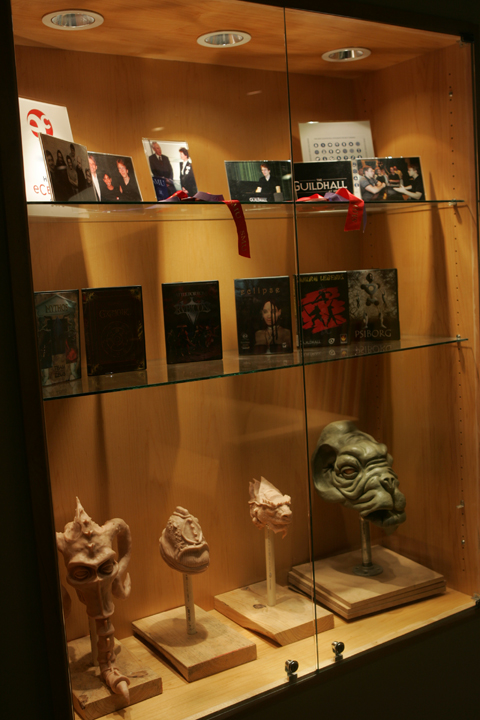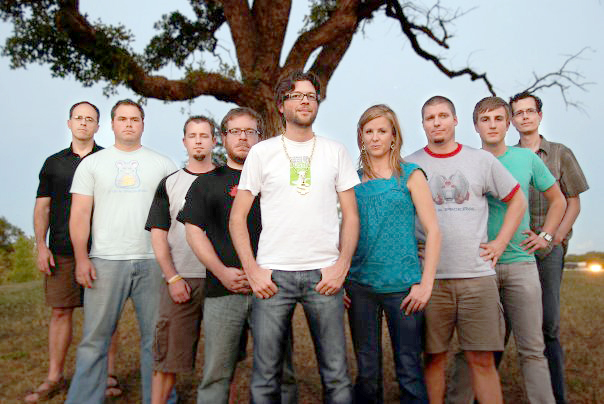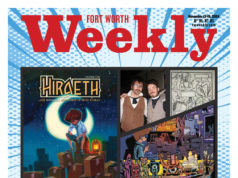“At Southern Methodist University, you can now major in video games. Finally, a degree more useless than political science.” – Jay Leno

Ashley Eldred was trying to figure out how to make Hell into a cuter place.
The young blonde woman with a confident manner is a student at the Guildhall at SMU – the school Jay Leno was talking about that teaches students how to make video games. On a recent morning, she and her colleagues were brainstorming about her idea for a game, which is called Hell’s Belle and concerns a heroine who tries to keep Hell from being overtaken by an invasion of cutesiness. Though she, like all the students here, is extremely tech-savvy, the air was popping with creative energy.
Ashley’s idea was one of two chosen by the lecturers and fellow students to be turned into working games, as final projects for the class. Ideas came thick and fast – should the main character’s enemies be monsters that were failing to be cute (someone suggested a giant scary demon with cat ears) or things that were genuinely cute but lethal (like the rabbit in Monty Python and the Holy Grail).
The class of 28 students is run by lecturers Sandy Petersen and Elizabeth Stringer, who, like the Guildhall’s other faculty, have no academic experience but long years of work in the industry that qualifies them to educate students in the game-making process. When Leno made his wisecrack years ago as host of The Tonight Show, he no doubt was imagining rooms full of guys in their 20s staring slack-jawed at screens, their hands practically glued to controllers and their brains locked in that focused yet numb mental state that often comes from playing video games for hours on end. True, the class was roughly 75 percent male and mostly in their 20s, but women and older men were also represented, and the fast, creative discussion didn’t leave any room for trance states.
Some people dismiss video games themselves as frivolous, but as a business they’re clearly no joke. While there’s talk that the video game industry is beginning to stagnate, it still took in $22 billion last year worldwide. Two weeks ago, the game Call of Duty: Modern Warfare 2 grossed $550 million in sales in its first five days, almost as impressive as the numbers for 2008’s biggest-selling movie, The Dark Knight, during its entire theatrical run and with a much smaller investment ($40 million to $50 million in production costs, as opposed to The Dark Knight‘s $185 million).
That kind of money can be a big boost to areas where video game companies tend to cluster, and Texas is beginning to get its share. Austin is home to more game companies than any U.S. region except Seattle and the San Francisco Bay area. In Austin, that translates to about 3,000 jobs.
The Dallas-Fort Worth area isn’t far behind with 22 gaming companies providing about 1,500 jobs thus far. The best known are Mesquite’s id Software – maker of the Castle Wolfenstein, Doom, and Quake games – and Plano’s Gearbox Software, which created Halo and Half-Life. With the Guildhall at SMU going full tilt and other local schools beginning to consider similar courses, the North Texas area is clearly hoping to take a bigger bite out of this lucrative market.
The Guildhall at SMU is run by Dr. Peter Raad, a cultivated, gray-haired man whose slightly accented speech indicates his Lebanese origins. The school’s name doesn’t refer to the building that houses it, but to the idea of guilds for artisans and skilled workers that dates back to the medieval period so beloved by gamers. Raad started as the founding director of the Hart eCenter for Interdisciplinary Studies in 2000, which was set up as a think tank to deal with the economic and cultural possibilities of the then-emerging technology of the internet. Two years later, the video game industry came looking for a school with both expertise in interactive technology and experience in teaching students from differing backgrounds.
At that point, the gaming industry was already out-earning Hollywood, and it needed trained professionals to keep up with product demand. “When you have such rapid expansion, the question is, do you have enough team members,” said Raad. “You need experts in animation, engine building, character modeling. One person can’t make a game anymore.”
Raad’s interdisciplinary background also shows in his conversation, which is strewn with similes from other kinds of work. In roughly an hour, he compares the teamwork among the gaming industry’s different sectors to that of lawyers, basketball players, and orchestra musicians. While video game education at other schools (such as IT University’s Center for Computer Games Research in Copenhagen) focuses on the theory and cultural significance of games, the Guildhall is more industry-oriented. “We are like a dental school,” said Raad, using another occupational comparison. “You go to dental school to become a dentist. You come here to design video games. We are about specific, channeled, professional preparation.”
To that end, the Guildhall offers an 18-month master’s program in interactive technology with a professional certificate in digital game development. A bachelor’s degree is required to get in, though not of any specific kind. Raad points out that his students have included military veterans, Wall Street brokers, architects, even an opera singer and an oil-rig worker. Students choose from among three specialties: art creation, level design (which involves storytelling and imagining the details of the world within the game), and software development (rendering the concepts from the other two into playable code). Each specialty requires a portfolio that is submitted as part of the application process.
The program is so intensive that few students can hold part-time jobs to help defray the $50,000 tuition cost, though financial aid and scholarships are available. There is a heavy emphasis on teamwork, and incoming students are placed on identical tracks called “cohorts” so that they work and study together throughout the 18 months. The school estimates that 96 percent of graduates land jobs in the video gaming industry, in which entry-level positions pay $40,000 to $50,000 a year. Top workers can pull down six-figure salaries (plus bonuses when the games they’ve worked on hit the market), and CEO pay and benefits can exceed $10 million.
 The program even includes psychological testing; on their first day, students are given the Myers-Briggs Type Indicator personality test. Stringer uses these to avoid personality conflicts when she’s assigning students to teams. “Having a cross-disciplinary creative team is unusual,” she said. “I was interested in a scientific approach to team building.” She also has the team meetings run in the style known as scrum, which features peer evaluations among students and daily five-minute standup meetings that emphasize maximum visibility and communication. This allows ideas to develop from low-level workers as much as from managers and allows the team to respond quickly to emerging problems and changing conditions. “The formal implementation has been outstanding,” she said.
The program even includes psychological testing; on their first day, students are given the Myers-Briggs Type Indicator personality test. Stringer uses these to avoid personality conflicts when she’s assigning students to teams. “Having a cross-disciplinary creative team is unusual,” she said. “I was interested in a scientific approach to team building.” She also has the team meetings run in the style known as scrum, which features peer evaluations among students and daily five-minute standup meetings that emphasize maximum visibility and communication. This allows ideas to develop from low-level workers as much as from managers and allows the team to respond quickly to emerging problems and changing conditions. “The formal implementation has been outstanding,” she said.
A blonde woman with a small, high-pitched voice and deep knowledge of what goes into making a game, Stringer worked for 15 years for Atari and Xatrix after graduating from the University of Southern California with a communications degree. When she first got into the industry, she said, getting hired “was very much a matter of who you knew and where you lived” because the work was being done only in certain small geographical areas. The gaming industry is still concentrated in nodes of activity, she said, but the nodes are getting bigger, and there are more of them.
Stringer said she never imagined a career in gaming and came to it through a corporate headhunter’s friend in Southern California. “I had to train all the new hires myself, and back then we were hiring lots more traditional artists than digital ones. I’d take their pads away, give them a digital pen, and say, ‘Learn to draw with this.’ “
A reporter working with a pen and pad can feel distinctly behind the technological curve when surrounded by students with laptops. The Guildhall at SMU issues a sleek black Dell XPS laptop to each student, paid for by the tuition.
The second project that the 2010 graduating class will work on, besides Hell’s Belle, is called Maglev, a puzzle-solving game pitched by a friendly, laid-back student named Shovaen Patel, who was on crutches thanks to a basketball injury the day the pen-wielding reporter visited. His game features a good robot battling evil robots to save its spaceship. The students will now spend the next semester working on one of those two projects, turning out a complete working game before they graduate. They must apply to Petersen and Stringer for lead positions on the teams just as they would apply for a job, with a resumé, cover letter, and interview.
Petersen divides the class in half and has the groups take turns going to Patel and Eldred for brainstorming sessions about their games. Patel’s idea is that the evil robots’ spaceship looks like it’s made out of Apple products, so part of the discussion turns on how to tweak the look of iPhones and Macs so that they seem threatening. As for Eldred’s game of keeping “cute” out of Hell, she seems to want a relatively dark feel. “I don’t want this to be a cute girl game where everything’s bright and cheery,” she said, but also doesn’t want to sacrifice the humor in the premise.
 Thinking outside the Xbox is routine at the Guildhall at SMU, where one of last fall’s projects was Dissonance, which took the engine for Half-Life 2 (a first-person shooter game) and created a music game. While all these students are massively tech-capable, the energy in this meeting was of the type that happens when creative artists work together. “I never imagined there’d be a place like this when I was in Abilene,” said Michael Brannan, a creative-writing major from Abilene Christian University who’s now studying level design. “We work really hard here, but it’s so much fun,” he added, echoing a thought expressed by several others.
Thinking outside the Xbox is routine at the Guildhall at SMU, where one of last fall’s projects was Dissonance, which took the engine for Half-Life 2 (a first-person shooter game) and created a music game. While all these students are massively tech-capable, the energy in this meeting was of the type that happens when creative artists work together. “I never imagined there’d be a place like this when I was in Abilene,” said Michael Brannan, a creative-writing major from Abilene Christian University who’s now studying level design. “We work really hard here, but it’s so much fun,” he added, echoing a thought expressed by several others.
The games are debugged and tested by classes at SMU’s main campus and occasionally by local high school classes. Students take the game through the processes of sales and marketing, going so far as to make cover art, posters, and a video trailer. The completed games are available if a publisher wants to put them on the market. So far none of the Guildhall’s games have made it that far, but the newest creations are exhibited each year, and the old ones remain in an online gallery, where graduates can point them out to potential employers as examples of their work.
The Guildhall at SMU may be at the forefront of gaming education, but it’s hardly alone. Programs have sprouted in the last few years at colleges all over America and the world. The graduate program at the University of Central Florida was modeled on the Guildhall. Vancouver’s Great Northern Way Campus, a collaboration among several British Columbia universities, includes a center to train gaming professionals. USC’s celebrated film school offers a minor in video gaming.
Locally, the University of North Texas was first to offer courses in video gaming, starting back in 1993. Their Laboratory for Recreational Computing offers an undergraduate certificate in game programming for students who complete four courses in game development. They’ve placed 51 alumni in positions at video game companies, including local outfits such as Dallas’ Bonfire Studios (creator of Age of Empires) and Lewisville’s Terminal Reality (BloodRayne).
“Game companies want what normal comp-sci classes teach,” said the lab’s director, Ian Parberry. He noted that UNT currently lacks the resources to enlarge the lab into a full-fledged department. “But who can tell what the future may change?”
A bigger enterprise is starting at the University of Texas at Arlington – a beginning gaming course that school officials hope will grow into a whole department. The course is run by Jim Galis, an engaging 52-year-old UTA graduate with 15 years experience in the game development field. He has worked as a computer graphics artist for flight simulators and then as a producer for Paradigm Entertainment, a local outfit that closed in November 2008.
The creative element was the biggest adjustment he had to make going between those two worlds, he said. “A flight simulator doesn’t use creativity. It’s just supposed to run like an F-16,” he said. “Game developers are in the business of making it fun. They have flexible hours and a different dress code. Coming from a structured background, it was hard for me to get my head around that at first.”
Galis started with Paradigm when it was an independent outfit and stayed on as ownership passed through the hands of Atari and THQ Entertainment prior to it being shuttered. “Indie gamers run the risk of not having a project to work on, not having that income,” he observed. “Atari gave us security, but then they put us on the block when they had financial trouble. It’s a trade-off.”
Next spring Galis will teach Gaming 1, a course intended to immerse students in the industry from an engineering standpoint. Students won’t get to actually build a game until his subsequent Gaming 2 course. “Making a game is difficult and time-consuming,” he said. “Lots of students don’t understand how much work goes into it. We want the students to have fun, but we have to start small. Right now it’s all about growing the program.” Despite the fact that UTA’s program will be aimed at undergraduates, Galis looks to the Guildhall at SMU as a model, calling it “very practical.”
 He acknowledged that North Texas lags behind the Austin area, especially when it comes to high-profile “massively multiplayer online” games such as the hugely popular fantasy game World of Warcraft. He also pointed out that Canadian cities such as Toronto and Montreal have attracted gaming companies because the government gives huge tax breaks that amount to 40 to 50 percent of their operating revenue. However, he said, even the workers from recently closed studios are forming their own small companies in North Texas. “There are lots of opportunities here.”
He acknowledged that North Texas lags behind the Austin area, especially when it comes to high-profile “massively multiplayer online” games such as the hugely popular fantasy game World of Warcraft. He also pointed out that Canadian cities such as Toronto and Montreal have attracted gaming companies because the government gives huge tax breaks that amount to 40 to 50 percent of their operating revenue. However, he said, even the workers from recently closed studios are forming their own small companies in North Texas. “There are lots of opportunities here.”
The business model for video games continues to evolve. The network of companies that puts out big games functions like Hollywood and its blockbuster movies. The hits are mega-sized, and more money comes in than with independent ventures, but the risks are greater because the production and overhead costs are higher and because relatively few games attain hit status. Electronic Arts (the manufacturer of Madden and other popular sports series) recently announced a loss of $1 billion last year and a coming round of layoffs. The financial news web site TheBigMoney.com recently ran an article questioning whether game companies are beginning to price themselves right out of the market – whether enough consumers in this economic climate will pay $60 for social music games like The Beatles: Rock Band.
Some companies resort to sequels that ensure a reliable franchise that can be milked year after year. Activision produces new versions of the Call of Duty, Guitar Hero and Tony Hawk game series on a regular basis. Though relying on franchises brings in strong sales, it often demonstrates lack of ingenuity and new intellectual properties, something that critics claim is necessary for firms to thrive in the ever-changing game world.
Activision CEO Bobby Kotick made himself a villain in that world recently by announcing that he would raise the retail prices on many games to $100 if he could and by dropping numerous profit-turning games made by a newly acquired competitor that didn’t “have … clear sequel potential and [didn’t] have the potential to become a $100 million franchise.” Kotick later softened his stance but maintained that “People are happy with sequels as long as you innovate within them.” With the money Modern Warfare 2 has made, it’s hard to disagree.
In this environment, smaller companies with lower operating costs are starting to make their presence felt. A recent article in The New York Times Magazine speculated on the prospect of independent gamers coming to the forefront in the same way that independent filmmakers have changed how Hollywood does business. (The puzzle-solving game Braid was compared to Easy Rider.)
“The industry will support both” – big companies and indies, Stringer said flatly, and Galis agreed.
 Galis noted the success of the game called Castle Crashers, developed by an indie firm ironically named The Behemoth in San Diego. “Lots of these guys want to make a cool game, not make $1 million,” he said, though the indie game developers probably wouldn’t mind if Apple or some other big company picked up their ideas and fattened their bank accounts. He pointed out that simple games, like those played on an iPhone, can be made by two people. Video gamers “started out in the garage, and now we’re going back there,” he said.
Galis noted the success of the game called Castle Crashers, developed by an indie firm ironically named The Behemoth in San Diego. “Lots of these guys want to make a cool game, not make $1 million,” he said, though the indie game developers probably wouldn’t mind if Apple or some other big company picked up their ideas and fattened their bank accounts. He pointed out that simple games, like those played on an iPhone, can be made by two people. Video gamers “started out in the garage, and now we’re going back there,” he said.
One such independent game maker is Josh Williams. Having grown up in Richardson and then Chicago, he moved to Southlake seven years ago. “Texas is a more welcoming place to start up a company,” he said, citing simpler tax laws and reporting requirements than in Illinois. “Plus, I wanted to get out of the cold.”
This 29-year-old home-schooling product with no high school degree (much less college) moved to Austin six months ago, but it was from his office in Southlake Town Square that he started Alamofire, a company that’s helping change another aspect of video gaming.
Alamofire’s main product is PackRat, a game played by logging onto Facebook. The object of the game is to gather complete sets of 15 to 20 cards from roughly a dozen different collections, each organized around a theme, ranging from forest creatures to zombies. Each card bears a distinctive bright, sharply colored illustration. Many collections include high-value cards that aren’t easy to find but can be “made” by combining lower-value cards, and the challenges of making these cards is a big part of what’s strangely addictive about the game. A player’s mind quickly falls into the game’s patterns – should I trade the luggage tag from the travel collection for the pigeon from the magic set, and if so, does that leave me with enough travel cards to make the scarcer cards?
One feature that makes PackRat unusual is that it retires collections from active duty rather than encouraging users to build on old cards. Users can trade cards among themselves or “steal” them (i.e., take them from someone else’s account, leaving behind a card of equal or even lower value in exchange) either from some characters on the site or from their Facebook friends. Even Facebook users who don’t play the game have an unused pool of cards to steal from.
Initial gameplay is free, but the idea is that gamers become so hooked on the free version that they’ll pay to play on a higher level. Cards can also be purchased from various virtual markets within the game by using “credits.” Every user begins with a certain number of credits, with opportunities to earn more by attaining certain levels within the game. However, they can also pay Alamofire money in exchange for more credits or access to more virtual markets within the game.
Exchanging real-world money for currency in a fictitious world isn’t new – a black market for virtual goods in World of Warcraft has existed for years, and the global trade in virtual currency is estimated at $5 billion to $6 billion a year, 75 percent of it generated by video games.
Bigwigs in the console game industry are now greedily eyeing the prospect of capturing the huge online game audiences. Zynga’s slate of online games such as FarmVille and Mafia Wars, for instance, reach a total of about 125 million active users each month. By comparison, the top-selling console game of 2008, Wii Play, sold 5.3 million copies.
Williams calls PackRat a “modest” success, with 400,000 casual users and 75,000 active monthly users, the latter number considered the main yardstick of success by the industry. “You’re reaching a different kind of user,” said Williams. “People who are on Facebook are there for other reasons, and when you throw a game in there, it’s like a perfect storm.”
 Alamofire’s numbers may be relatively small, but it has an advantage in that there’s not much turnover among its users. USA Today recently quoted an estimate that 25 to 33 percent of players play a game for two or three months before moving on to something else, with only 5 percent staying on for more than a year. Williams, however, reports that most of PackRat’s hardcore users have been with the company for six months, and the number of users has been holding steady in the last year.
Alamofire’s numbers may be relatively small, but it has an advantage in that there’s not much turnover among its users. USA Today recently quoted an estimate that 25 to 33 percent of players play a game for two or three months before moving on to something else, with only 5 percent staying on for more than a year. Williams, however, reports that most of PackRat’s hardcore users have been with the company for six months, and the number of users has been holding steady in the last year.
One plus of having your video game played through Facebook is that you get precise demographic data on users, and the figures on PackRat yield one major surprise. Williams estimates that 75 percent of PackRat’s players are women, most of them age 25 to 40. “We didn’t design it that way,” he said, noting that the game isn’t violence-oriented like so many other console and online games, and its collaborative nature goes hand in hand with what Facebook does. “Being on a social network is going to skew you a little bit female to begin with. PackRat is cute and friendly,” he said. “There’s no endgame that you have to get to, no winners or losers, and no leader board that you have to progress through.”
Alamofire is not currently turning a profit, in large part because the company is reinvesting most of its income from PackRat into its new game, Gowalla, which encourages users to travel.
 North Texas has a strong pool of programmers for console games, Williams said, but he moved the company to Austin to find more programmers for internet games. “Dallas just doesn’t have a strong urban creative core for tech companies, and because DFW is so sprawling, it’s harder to gather a concentrated number of tech folks in a small area,” he said.
North Texas has a strong pool of programmers for console games, Williams said, but he moved the company to Austin to find more programmers for internet games. “Dallas just doesn’t have a strong urban creative core for tech companies, and because DFW is so sprawling, it’s harder to gather a concentrated number of tech folks in a small area,” he said.
“Unless you’re Mark Cuban, there’s little savvy tech investment going on as it relates to consumer web products and games” in North Texas, Williams said. “Until there’s a concentration of community, investment, and university support,” the region “will have a hard time making a name for itself like Austin, Seattle, or Silicon Valley. There are glimmers of hope, but it needs lots of nurturing.”
The increase in smaller studios like Alamofire even has some observers predicting that video games will rise to the level of an art form, to be studied and respected as much as novels or paintings. Galis compared the experience of playing Thatgamecompany’s Flower (also mentioned in the New York Times piece) to playing a piece of art.
Not only are aesthetics evolving, but game developers are increasingly trying to address weighty real-world issues through their games. In one of the Guildhall’s projects from fall 2008, Extinction, players choose to be either a dinosaur or a caveman, as the two species compete for food in a prehistoric world after a meteor crash. In one proposed game at Guildhall that didn’t make the final cut this semester, the player took on the role of a guerrilla photographer working to expose corruption in a fictitious third-world dictatorship.
“Serious games are for education, military training, and even health,” said Galis. “Games aren’t just for entertainment any more.”











